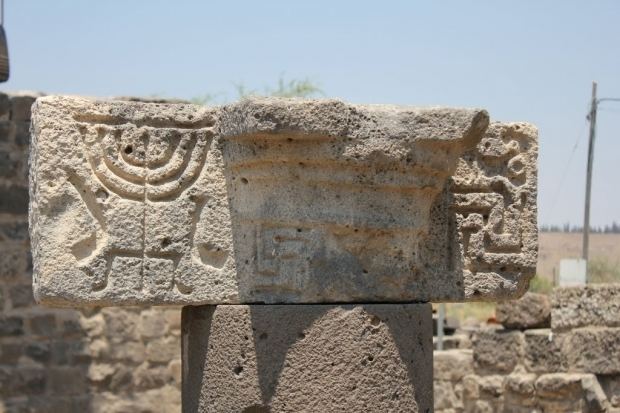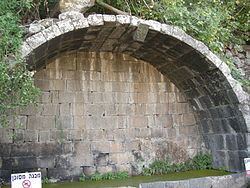 | ||
Similar Nachal Samach, Ein Pik, Golan Archaeological Museum, Katzrin ancient village an, Rujm el‑Hiri | ||
The ancient synagogue in umm el kanatir golan heights israel
Um el Kanatir (Umm al-Qanāṭir, ام القناطر; Hebrew: אם הקשתות, lit. "Mother of the Arches") is an archaeological site on the Golan Heights dated to the 6th-8th centuries. Excavations have revealed a Roman-era Jewish city and synagogue. The site is located 10 kilometers east of the Dead Sea Transform, two kilometers west of Kibbutz Natur.
Contents
- The ancient synagogue in umm el kanatir golan heights israel
- Etymology
- History
- Reconstruction
- References

Etymology

The name of the site derives from its location 200 meters from a natural spring that flows from the cliff into three basins that were once topped by monumental basalt arches, one of which has survived.
History

The site is believed to have been a pagan Roman town that venerated the nearby spring. Jews began to settle in the vicinity in 23 BCE. Early Jewish inhabitants of Umm el-Kanatir established a flax industry there, using the water for washing and whitening flax from which they wove fine cloth. The textiles were sold to wealthy residents in the nearby towns of Sussita and Beit Saida. The villagers may have engaged in mixed farming, and raised sheep and olives, although no terracing has been found.

In the sixth century, the Jewish residents built a large synagogue, apparently embellishing an earlier synagogue. The building was 18 meters (59 feet) long by 13 meters (43 feet) wide and calculated to have been 12 meters (39 feet) high, making it one of the largest of at least 25 ancient synagogues discovered in the region. It was destroyed in the Golan earthquake of 749.

Local Syrian shepherds continued to inhabit the ruins of Umm el-Kanatir into the 1950s, reusing the carved lintels and stones.

The existence of a synagogue at the site was first documented in 1884, by Laurence Oliphant and Gottlieb Schumacher. Amid ruined walls and large blocks of stone, Oliphant discovered a stone carving of an eagle, a fragment of a cornice, a large triangular slab that he believes was placed on the lintel of the main entrance and fragments of Corinthian capitals.
The eagle, a well-known motif in ancient Jewish art, is visible on a double column and on the front gable of the synagogue.
Reconstruction
Reconstruction of the synagogue is under way, supervised by Yehoshua Dray and Haim Ben-David of Kinneret Academic College and Bar-Ilan University. The project, inaugurated in 2003, uses special high-tech computer technology to code and digitally record the stones. Blocks are then labeled with computer chips and a special crane lifts and inserts them in the correct sequence. With the help of this technology, archaeologists believe the synagogue is being restored with great accuracy.
